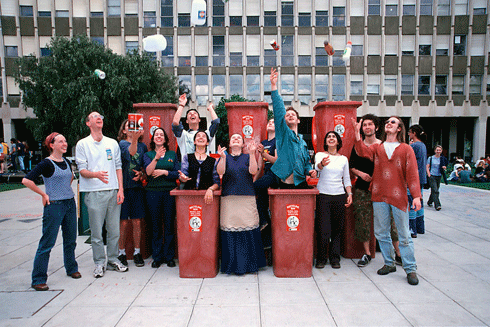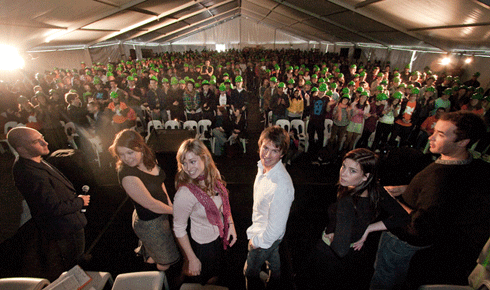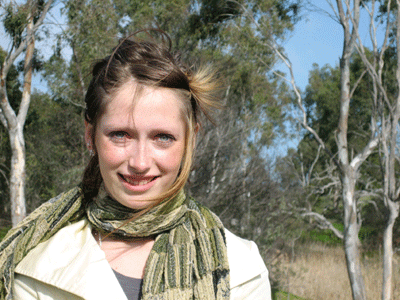
|
Published:
Rising force
Youth coalitions are forming across Australia, often in the form of dispersed networks, to take a proactive, mainstream stake in the environmental change agenda. With smart use of technology they are becoming a voice not be ignored. Robin Taylor reports.
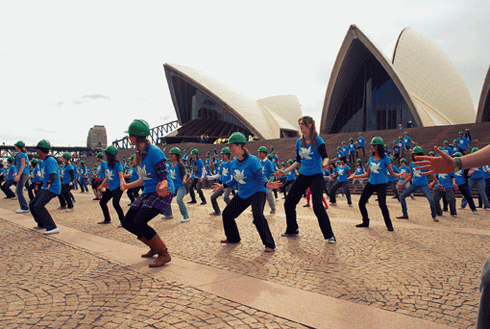
|
|
Powershift, conducted by the AYCC in July, saw 1200 young people from a range of backgrounds gather in Sydney to discuss climate action strategies. Credit: Daryl Orillaza for AYCC
|
The emergence of a strong youth voice for environmental action – particularly on climate change – is hardly surprising. Recent polling by the Climate Institute1 backs up wider findings that younger people are much more concerned about progress on climate change mitigation than older Australians. The nature and rapid spread of this growing generational push for proactive policy reflects a can-do attitude and savvy use of today’s powerful, highly democratic social media technology.
A bushwalking holiday in Tasmania’s old-growth forests while reading Tim Flannery’s book The Weather Makers was the catalyst that led to the growth of a powerful coordinated youth movement on climate change. Co-founder of the Australian Youth Climate Coalition (AYCC), Amanda McKenzie, says that looking at some of the oldest trees in the world and reading about how humans could be changing the whole planet in less than a generation brought home to her how serious the problem was.
Amanda and Sydney student Anna Rose, a past national convenor of the Australian Student Environment Network (ASEN), launched the AYCC in February 2007 with the objective of mobilising young people to solve climate change. AYCC links a wide range of youth organisations.
‘The ability to connect using social networking tools and internet technology means that young people can do in an instant what would have taken previous generations months to do,’ says Amanda.
‘But, more importantly, young people have the moral high ground on this issue because they will be the generation most affected if inadequate action is taken. Many of them can’t vote but the decisions being made will definitely affect their future.’

|
|
Left to right: Anna Rose, Amanda McKenzie, Ellen Sandell, Sarah Kucera and actor Brooke Satchwell, members of the leadership team behind Powershift for AYCC. Credit: Pinar Cildiroglu for AYCC
|
The maturation of the youth climate movement in Australia became evident with the staging of the Powershift conference in Sydney in July. Around 1200 participants aged 14 to 26 converged on what was billed as Australia’s first national youth summit. It was based on a precursor event first held in the US in 2007 where 6000 young people met in Washington D.C.
Through a range of activities supported by non-government organisations (NGOs) and key commentators, the forum aimed to educate young people about how they can take action on climate change.
After two-and-a-half years, the AYCC has grown from nothing to an operation with an annual budget of $500 000 with offices in Melbourne, Sydney and Brisbane.
At any time, 350 to 400 volunteers around the country may be supporting its activities, most of them aged between 19 and 21, although its membership covers a broader age group from 12 to 29 year olds.
And politicians are taking notice. At the 2008 climate change talks in Poznan, Poland, McKenzie says AYCC was the only NGO to be granted a meeting with Australia’s Climate Change Minister, Penny Wong. McKenzie and Rose were also the only youth representatives interviewed by Australia’s Senate Committee on climate policy.
Following the Powershift conference, which McKenzie describes as the biggest per capita organising of young people in the world around climate change, the organisation’s next big campaign is ‘Youth Decide,’ a national campaign jointly organised with World Vision, which McKenzie says is about giving the generation who will be most affected by the decisions made at Copenhagen the opportunity to vote for the world they want to inherit.
‘The first aim is to get tens of thousands of young people voting online so we can take that message to the UN. The second is to get young people to hold local voting events and invite politicians and the media along to show what young people are doing about climate change,’ she says.
The AYCC has also started a project to support Pacific Island countries in their preparations for the UN talks in Copenhagen.
‘We have the ambitious idea that we can create a nationwide movement of young people who are going to be united,’ says McKenzie.
And, with enquiries being received weekly from countries wanting to start their own youth climate initiatives, the coalition is already part of a global movement.
The University of Sydney’s Dr Ariadne Vromen, a senior lecturer in the School of Social and Political Sciences with a special interest in political participation by young people in Australia, says it is natural that young people want to get involved in the debate on climate change, which is the biggest issue of our time.
She says although evidence is scarce about the extent of the youth environmental movement, young people are definitely becoming more prominent in environmental activism.
She believes this is partly due to the fact that children are being taught to have an environmental consciousness from an early age.
‘In primary school, particularly, children are being given environmental messages – be it a geography class, a civics class or planting a school garden, it becomes normalised from a very young age.’
Dr Vromen says it is hard to gauge the impact of the youth environment movement, although it is definitely getting more recognition as a lobby and advocacy group.
‘At the same time, there are quite a number of more radical grassroots oriented environmental groups that are engaging in direct action, such as the youth-led, Newcastle-based group, Rising Tide, which is campaigning against coal exports,’ she says.
On the other hand, Dr Vromen believes a feature of the youth environment movement is their willingness to work with business and form coalitions that would ordinarily be anathema to social movements. ‘Sustainability has become a broader idea for them and these types of partnerships are being forged, it’s not as oppositional as it was before.’
The Green Steps program at Monash University is one initiative that takes this approach. The program, which was developed by a group of students, is now offered through host universities in Adelaide, Brisbane, Canberra, Sydney and Perth.
Manager of the program, Mark Boulet, says Green Steps works with organisations to reduce their environmental impact.
‘It’s also about empowering young people who are about to enter the workforce and integrating sustainability across disciplines,’ he says.
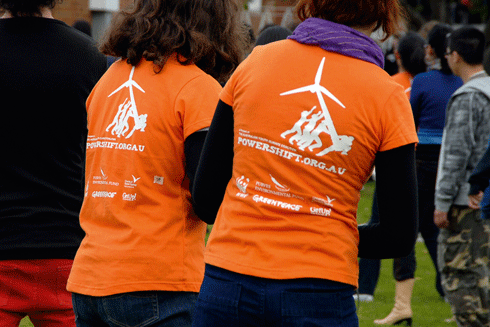
|
|
Volunteers, many already part of AYCC’s national efforts, helped make Powershift a success. Credit: Pinar Cildiroglu for AYCC
|
One former participant in the program is Taegen Edwards, a researcher on the social impacts of climate change at the McCaughey Centre, who did the Green Steps course while completing an arts/commerce degree. She says it was instrumental in her decision to seek a career focused on environmental issues as well as putting her on the path to an involvement in the grassroots climate movement.
‘It gave me a sense that I was a legitimate environmentalist as well as [giving me] practical skills, and, most importantly, access to a network of people working in the environmental sector,’ she says.
These days, Taegen spends much of her spare time in the grassroots climate movement as a member of Yarra Climate Action Now, a Melbourne-based climate action group.
‘The more I read about climate change and its escalating scale, the more urgent I realise the need for change is. We need collective community action to create broad-scale political and social change, which is where I want to focus my efforts.’
Dr Vromen says that some youth climate action groups are being quite successful at obtaining funding from NGOs and state governments, who recognise that they are filling a broader federal policy vacuum.
AYCC’s Amanda McKenzie also believes that frustration at the government’s inaction is a reason for many people becoming involved in the movement.
‘A lot of people have become disillusioned with the Rudd Government and believe the Prime Minister is not fulfilling the mandate he was voted in on – climate action. This includes many young people who have not been politically engaged before,’ she says.
Founder of the Centre for Sustainability Leadership, Larissa Brown, is also critical of the lack of more assertive action by the Australian Government.
‘On the issue of climate change, in the past Australia has been running towards a cliff. Under Mr Rudd’s emission trading scheme we are now jogging towards that cliff. We need to stop, turn around and head in a whole new direction.’
Larissa believes leadership is the solution to the sustainability crisis and her goal is to create a network of sustainability leaders working collaboratively towards powering global change.
In 2006, at the age of 24, Larissa founded the Centre for Sustainability Leadership to give young people the leadership and advocacy skills they need to develop a more sustainable world.
‘We’ve tried to get people in positions of power to care; now we’re going to get people who care into positions of influence,’ she says.
The centre aims to empower young people to make a measurable impact in their community towards creating a sustainable future. Over the past two years more than 100 people from a wide range of backgrounds have graduated from its fellowship program.
As part of the program, participants work on a sustainability project, which is judged on criteria including innovation and level of impact. As a result, the program has acted as the catalyst for dozens of projects within business and the wider community.
These include, for example, a project developed by participant Rachel Lowry of Zoos Victoria to encourage the public to recycle mobile phones and thus reduce the demand for coltan mining in threatened gorilla habitat. Another project, ‘Just Change’, has brought together the Real Estate Institute of Victoria, Sustainability Victoria and the Tenants Union of Victoria to bring energy efficiency initiatives to the private rental market.
Sustainability initiatives are also the focus of a new AIESEC project at the University of Adelaide. AIESEC (Association Internationale des Étudiants en Sciences Économiques et Commerciales) is a global student network, founded in 1948, which focuses on exchange internships for students. The University of Adelaide project is developing sustainability themed exchanges.
AIESEC President at the University of Adelaide, Steven Burnside, says the project aims to get local industry, such as organisations involved in water management or other sustainable practices, as partners to employ students. The group is also hoping to set up exchanges for Adelaide engineering students in India, for a two-way exchange of knowledge on water sustainability issues.
|
Karina Donkers, a student at Deakin University, formed Geelong Youth for Climate Action 12 months ago to raise awareness about climate change and the issues that will affect young people. As well, she wanted to give young people a way to participate. |
‘Many of the people who do care about climate change don’t have an outlet so they feel powerless,’ she says. |
‘Because we are young people, we don’t have the money to put up solar panels ... we are normally renting.’ |
Karina says the group’s aims are both political and educational. ‘We want to educate the youth in the area about climate change and also to help put pressure on government,’ she says. |
‘That’s what we are trying to create; change from the bottom up.’ |
The group, which already has about 30 members, took part in the first Geelong Walk against Warming last year, and this year will be running a couple of voting events as part of Youth Decide. |
‘Some members are more interested in what we can do in our community to make it more sustainable, some are more focused on education and raising awareness, while others are more interested in putting political pressure on the government,’ Karina says. |
Although the group is still becoming established, Karina has already been contacted by local politicians, and the City of Greater Geelong sponsored her to attend Powershift this year. This shows even small youth groups’ views are being noticed by government. |
‘It is really important to illustrate to the government that young people care and are worried about the [climate] issue because I think politicians have been deaf to us,’ she says. |
‘We haven’t really had a voice ... If we want change, we need to stop relying on other people and make it our issue.’ |
Another student network that links the environmental groups of universities around Australia is the Australian Student Environment Network (ASEN), whose activities range from coordinating major campaigns on environmental issues to training and skill sharing on campaign strategy and civil disobedience.
ASEN national convenor Lian Sinclair, from the University of Western Australia Environment Collective, says the network and its members have been successful on a number of campuses (including Monash, Sydney and Newcastle universities) in implementing clean energy policies.
This year ASEN is organising four ‘climate camps’ around Australia in the lead up to and aftermath of the Copenhagen COP15 international climate meeting in December, aimed at mobilising people against polluting industry, particularly coal.
‘When we do big events like this we can have big impacts on the national – and consequently international – politics of climate change,’ says Sinclair.
It’s clear the power of the internet linked to mobile telecommunications is a central force for youth climate efforts, not just facilitating the formation of their core membership, but also linking new organisations across national and international borders to form rapid response networks that are likely to help drive the outcomes they want.
More information:
Australian Youth Climate Coalition, www.aycc.org.au
Green Steps, www.monash.edu/research/sustainability.../green-steps/
AIESEC, www.aiesecaustralia.org
Centre for Sustainability Leadership, www.csl.org.au
Australian Student Environment Network, www.asen.org.au
1 In a survey carried out in August 2009, 60 per cent of people aged 18–24 compared to 32 per cent of people aged 65–74 think the Federal Parliament is moving too slowly to address climate change.


